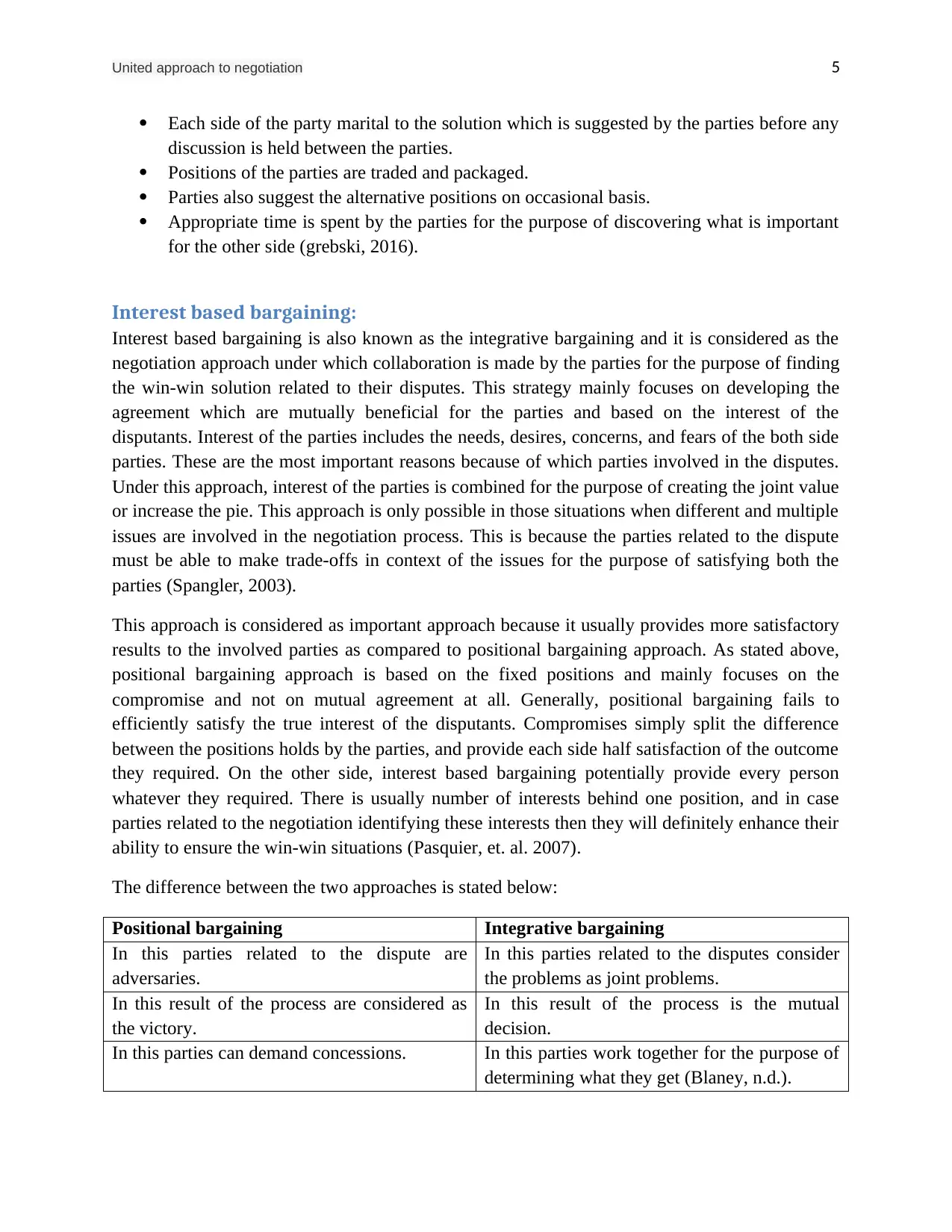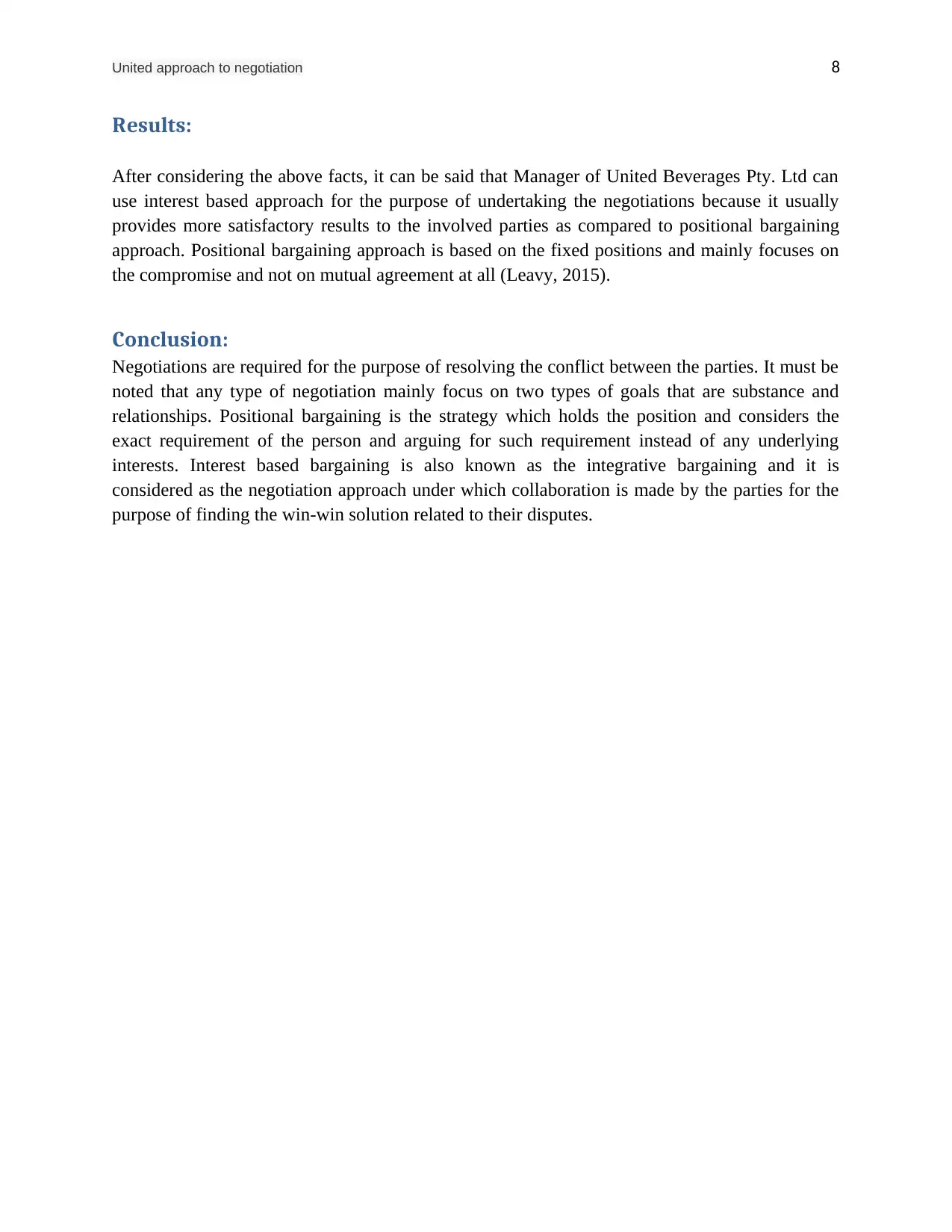BCOM101 Business Communication: Report on Negotiation Approaches
VerifiedAdded on 2023/06/11
|10
|2794
|181
Report
AI Summary
This report provides an analysis of two primary negotiation approaches: positional bargaining and interest-based bargaining. Positional bargaining is characterized by fixed positions and competitive tactics, while interest-based bargaining focuses on collaboration and mutually beneficial solutions. The report explores the characteristics, assumptions, and risks associated with each approach, along with their impact on relationships. It concludes that interest-based bargaining is generally more effective for achieving satisfactory outcomes and fostering positive relationships. The report supports the use of interest-based approach for United Beverages Pty. Ltd. and emphasizes the importance of understanding the nuances of each strategy for successful negotiation. Desklib offers a wealth of similar solved assignments and past papers for students.

United Approach to negotiation 1
United Approach to negotiation
United Approach to negotiation
Paraphrase This Document
Need a fresh take? Get an instant paraphrase of this document with our AI Paraphraser

United approach to negotiation 2
Executive Summary:
Negotiation is considered as the communication process in which an attempt is made by the
individual for the purpose of influencing another person to make decision in the favor of person.
Negotiations can be done either on the situations or things that are tangible in nature. This paper
defines the two types of approaches that are positional bargaining and interest based bargaining.
This paper supports the interest based bargaining system because this approach supports the win-
win situation.
Executive Summary:
Negotiation is considered as the communication process in which an attempt is made by the
individual for the purpose of influencing another person to make decision in the favor of person.
Negotiations can be done either on the situations or things that are tangible in nature. This paper
defines the two types of approaches that are positional bargaining and interest based bargaining.
This paper supports the interest based bargaining system because this approach supports the win-
win situation.

United approach to negotiation 3
Contents
Executive Summary:....................................................................................................................................2
Introduction:...............................................................................................................................................4
Characteristics related to each approach:...................................................................................................4
Positional bargaining:..............................................................................................................................4
Interest based bargaining:.......................................................................................................................5
Assumptions related to the approaches:.....................................................................................................6
Positional bargaining:..............................................................................................................................6
Interest based bargaining:.......................................................................................................................6
Risk related to the approaches:...................................................................................................................6
Positional bargaining:..............................................................................................................................6
Interest based bargaining:.......................................................................................................................7
Impact on relationships of each approach:.................................................................................................7
Positional bargaining:..............................................................................................................................7
Interest based bargaining:.......................................................................................................................7
Results:........................................................................................................................................................8
Conclusion:..................................................................................................................................................8
References:..................................................................................................................................................9
Contents
Executive Summary:....................................................................................................................................2
Introduction:...............................................................................................................................................4
Characteristics related to each approach:...................................................................................................4
Positional bargaining:..............................................................................................................................4
Interest based bargaining:.......................................................................................................................5
Assumptions related to the approaches:.....................................................................................................6
Positional bargaining:..............................................................................................................................6
Interest based bargaining:.......................................................................................................................6
Risk related to the approaches:...................................................................................................................6
Positional bargaining:..............................................................................................................................6
Interest based bargaining:.......................................................................................................................7
Impact on relationships of each approach:.................................................................................................7
Positional bargaining:..............................................................................................................................7
Interest based bargaining:.......................................................................................................................7
Results:........................................................................................................................................................8
Conclusion:..................................................................................................................................................8
References:..................................................................................................................................................9
⊘ This is a preview!⊘
Do you want full access?
Subscribe today to unlock all pages.

Trusted by 1+ million students worldwide

United approach to negotiation 4
Introduction:
Negotiation is considered as the process of making the joint decisions at the time when parties
related to the negotiation have different and opposite preferences. Negotiation is considered as
the special significance in context of conflicts, whether such conflict arise between the union and
management of the organization or between the countries. In these situations, negotiations are
required for the purpose of resolving the conflict between the parties. Generally, conflicts and
difference in opinions are arise in the work settings between the parties such as matters related to
the wages, performance evaluation, working conditions, job assignments, schedules related to the
work, etc (Management study HQ, n.d.).
It must be noted that any type of negotiation mainly focus on two types of goals that are
substance and relationships. Conclusion of agreement related to the wage increases can be
considered as achievement of the substance goal, and the relationship goals deals with the results
which considered how well parties related to the negotiations are able to work well with each
other, once the process related to the negotiation is completed.
The main aim of this paper is to conduct research on two approaches related to negotiation that
are competitive positional-based negotiation and problem solving interest based negotiation.
Structure of this report includes characteristics related to both the approaches, assumption related
to the each approach, risk related to the each approach, and impact on relationships of the each
approach. Lastly, brief conclusion is written for concluding the important facts of this paper.
Characteristics related to each approach:
The basic form of the negotiation includes two different strategies that are advocate’s approach
and the win-win negotiators approach. From these two approaches, we also have two additional
strategies that are interest based bargaining which is also known as integrative, or cooperative
bargaining, and second is the positional bargaining which is also known as the distributive or
competitive bargaining (management study HQ, n.d.).
Positional bargaining:
Positional bargaining is considered as that negotiation approach which mainly based on the fixed
idea. In other words, this is the strategy which holds the position and considers the exact
requirement of the person and arguing for such requirement instead of any underlying interests.
Positional bargaining is the first choice of the people while entering into the negotiation
(Tremblay, 2016). Following are the most important characteristics of the positional bargaining
approach:
Each side of the party related to the negotiation introduces their own solution.
Each side of the party is left to assume which problem related to the solution from the
other side is intended to solve.
Introduction:
Negotiation is considered as the process of making the joint decisions at the time when parties
related to the negotiation have different and opposite preferences. Negotiation is considered as
the special significance in context of conflicts, whether such conflict arise between the union and
management of the organization or between the countries. In these situations, negotiations are
required for the purpose of resolving the conflict between the parties. Generally, conflicts and
difference in opinions are arise in the work settings between the parties such as matters related to
the wages, performance evaluation, working conditions, job assignments, schedules related to the
work, etc (Management study HQ, n.d.).
It must be noted that any type of negotiation mainly focus on two types of goals that are
substance and relationships. Conclusion of agreement related to the wage increases can be
considered as achievement of the substance goal, and the relationship goals deals with the results
which considered how well parties related to the negotiations are able to work well with each
other, once the process related to the negotiation is completed.
The main aim of this paper is to conduct research on two approaches related to negotiation that
are competitive positional-based negotiation and problem solving interest based negotiation.
Structure of this report includes characteristics related to both the approaches, assumption related
to the each approach, risk related to the each approach, and impact on relationships of the each
approach. Lastly, brief conclusion is written for concluding the important facts of this paper.
Characteristics related to each approach:
The basic form of the negotiation includes two different strategies that are advocate’s approach
and the win-win negotiators approach. From these two approaches, we also have two additional
strategies that are interest based bargaining which is also known as integrative, or cooperative
bargaining, and second is the positional bargaining which is also known as the distributive or
competitive bargaining (management study HQ, n.d.).
Positional bargaining:
Positional bargaining is considered as that negotiation approach which mainly based on the fixed
idea. In other words, this is the strategy which holds the position and considers the exact
requirement of the person and arguing for such requirement instead of any underlying interests.
Positional bargaining is the first choice of the people while entering into the negotiation
(Tremblay, 2016). Following are the most important characteristics of the positional bargaining
approach:
Each side of the party related to the negotiation introduces their own solution.
Each side of the party is left to assume which problem related to the solution from the
other side is intended to solve.
Paraphrase This Document
Need a fresh take? Get an instant paraphrase of this document with our AI Paraphraser

United approach to negotiation 5
Each side of the party marital to the solution which is suggested by the parties before any
discussion is held between the parties.
Positions of the parties are traded and packaged.
Parties also suggest the alternative positions on occasional basis.
Appropriate time is spent by the parties for the purpose of discovering what is important
for the other side (grebski, 2016).
Interest based bargaining:
Interest based bargaining is also known as the integrative bargaining and it is considered as the
negotiation approach under which collaboration is made by the parties for the purpose of finding
the win-win solution related to their disputes. This strategy mainly focuses on developing the
agreement which are mutually beneficial for the parties and based on the interest of the
disputants. Interest of the parties includes the needs, desires, concerns, and fears of the both side
parties. These are the most important reasons because of which parties involved in the disputes.
Under this approach, interest of the parties is combined for the purpose of creating the joint value
or increase the pie. This approach is only possible in those situations when different and multiple
issues are involved in the negotiation process. This is because the parties related to the dispute
must be able to make trade-offs in context of the issues for the purpose of satisfying both the
parties (Spangler, 2003).
This approach is considered as important approach because it usually provides more satisfactory
results to the involved parties as compared to positional bargaining approach. As stated above,
positional bargaining approach is based on the fixed positions and mainly focuses on the
compromise and not on mutual agreement at all. Generally, positional bargaining fails to
efficiently satisfy the true interest of the disputants. Compromises simply split the difference
between the positions holds by the parties, and provide each side half satisfaction of the outcome
they required. On the other side, interest based bargaining potentially provide every person
whatever they required. There is usually number of interests behind one position, and in case
parties related to the negotiation identifying these interests then they will definitely enhance their
ability to ensure the win-win situations (Pasquier, et. al. 2007).
The difference between the two approaches is stated below:
Positional bargaining Integrative bargaining
In this parties related to the dispute are
adversaries.
In this parties related to the disputes consider
the problems as joint problems.
In this result of the process are considered as
the victory.
In this result of the process is the mutual
decision.
In this parties can demand concessions. In this parties work together for the purpose of
determining what they get (Blaney, n.d.).
Each side of the party marital to the solution which is suggested by the parties before any
discussion is held between the parties.
Positions of the parties are traded and packaged.
Parties also suggest the alternative positions on occasional basis.
Appropriate time is spent by the parties for the purpose of discovering what is important
for the other side (grebski, 2016).
Interest based bargaining:
Interest based bargaining is also known as the integrative bargaining and it is considered as the
negotiation approach under which collaboration is made by the parties for the purpose of finding
the win-win solution related to their disputes. This strategy mainly focuses on developing the
agreement which are mutually beneficial for the parties and based on the interest of the
disputants. Interest of the parties includes the needs, desires, concerns, and fears of the both side
parties. These are the most important reasons because of which parties involved in the disputes.
Under this approach, interest of the parties is combined for the purpose of creating the joint value
or increase the pie. This approach is only possible in those situations when different and multiple
issues are involved in the negotiation process. This is because the parties related to the dispute
must be able to make trade-offs in context of the issues for the purpose of satisfying both the
parties (Spangler, 2003).
This approach is considered as important approach because it usually provides more satisfactory
results to the involved parties as compared to positional bargaining approach. As stated above,
positional bargaining approach is based on the fixed positions and mainly focuses on the
compromise and not on mutual agreement at all. Generally, positional bargaining fails to
efficiently satisfy the true interest of the disputants. Compromises simply split the difference
between the positions holds by the parties, and provide each side half satisfaction of the outcome
they required. On the other side, interest based bargaining potentially provide every person
whatever they required. There is usually number of interests behind one position, and in case
parties related to the negotiation identifying these interests then they will definitely enhance their
ability to ensure the win-win situations (Pasquier, et. al. 2007).
The difference between the two approaches is stated below:
Positional bargaining Integrative bargaining
In this parties related to the dispute are
adversaries.
In this parties related to the disputes consider
the problems as joint problems.
In this result of the process are considered as
the victory.
In this result of the process is the mutual
decision.
In this parties can demand concessions. In this parties work together for the purpose of
determining what they get (Blaney, n.d.).

United approach to negotiation 6
Assumptions related to the approaches:
Positional bargaining:
Following are the basic assumptions related to the positional bargaining:
In this approach negotiation between the parties is controlled by the egocentric self-
interest of the parties.
In this underlying motivation between the parties is competitive in nature.
Very few resources are available under this approach.
This negotiation does not affect the future of the parties involved in the dispute.
The main purpose under this approach in context of parties is to win.
This negotiation approach mainly considered as the game of winning and loose (morgan,
2006).
Interest based bargaining:
Following are the basic assumptions related to the Interest based bargaining:
The most important assumption related to this approach is conciliatory and cooperative.
In this approach parties related to the dispute are directed to share information with each
other (Benzoni, et. al. 2002).
The spirit of this approach is both the parties help each other in succeed.
In this approach parties automatically assumes that mutual gain is possible.
Under this approach both the parties related to the dispute are optimistic in nature
(Ventello, n.d.).
Risk related to the approaches:
Positional bargaining:
Sometimes, this approach also creates issues, as whenever negotiations extend, the parties
involved in the negotiations committed more towards their positions, and defend themselves on
continuous basis. A strong commitment of the parties towards their position generally results in
the lack of attention of both the parties in the underlying interests. Therefore, any agreement that
is concluded between the parties reflect the mechanical splitting in context of difference between
the final positions instead of the solution that is carefully drafted by the parties for the purpose of
fulfilling the parties legitimate interest (Rahwan, et. al., 2004).
Therefore, this strategy is considered as the less constructive and less efficient for the negotiation
purpose. This strategy usually does not result in the win-win outcome and maximum times
develop bad feeling between the negotiators. In other words, this approach develops the feelings
Assumptions related to the approaches:
Positional bargaining:
Following are the basic assumptions related to the positional bargaining:
In this approach negotiation between the parties is controlled by the egocentric self-
interest of the parties.
In this underlying motivation between the parties is competitive in nature.
Very few resources are available under this approach.
This negotiation does not affect the future of the parties involved in the dispute.
The main purpose under this approach in context of parties is to win.
This negotiation approach mainly considered as the game of winning and loose (morgan,
2006).
Interest based bargaining:
Following are the basic assumptions related to the Interest based bargaining:
The most important assumption related to this approach is conciliatory and cooperative.
In this approach parties related to the dispute are directed to share information with each
other (Benzoni, et. al. 2002).
The spirit of this approach is both the parties help each other in succeed.
In this approach parties automatically assumes that mutual gain is possible.
Under this approach both the parties related to the dispute are optimistic in nature
(Ventello, n.d.).
Risk related to the approaches:
Positional bargaining:
Sometimes, this approach also creates issues, as whenever negotiations extend, the parties
involved in the negotiations committed more towards their positions, and defend themselves on
continuous basis. A strong commitment of the parties towards their position generally results in
the lack of attention of both the parties in the underlying interests. Therefore, any agreement that
is concluded between the parties reflect the mechanical splitting in context of difference between
the final positions instead of the solution that is carefully drafted by the parties for the purpose of
fulfilling the parties legitimate interest (Rahwan, et. al., 2004).
Therefore, this strategy is considered as the less constructive and less efficient for the negotiation
purpose. This strategy usually does not result in the win-win outcome and maximum times
develop bad feeling between the negotiators. In other words, this approach develops the feelings
⊘ This is a preview!⊘
Do you want full access?
Subscribe today to unlock all pages.

Trusted by 1+ million students worldwide

United approach to negotiation 7
of competition between the parties related to the negotiation, and this result in the unsatisfied
feeling in the one side party related to the negotiation. There are number of decision in context of
which this strategy does not work and proves insufficient. It can be said that the more strong
opening position of the parties take more time in reaching the negotiation (Maxwell, n.d.).
Interest based bargaining:
The biggest issue related to this approach is the dangerous expectations, which means this
approach create unnecessary and dangerous expectations in the minds of the parties, which stated
that all the problems will be resolved and all the interest of the parties will be addressed. This
can sharply contrast with the expectations in terms of the traditional bargaining under which
participants clearly knows that they are not able to achieve all or even maximum number of their
goals in the single process of the negotiation (Barret, 2015). This approach also states the
attractive nick name of “win-win bargaining” which also create assumption in the mind of people
that all their expectation will be fulfilled. It reflects the people that there are mutual and shared
interest which is hold by both labor and management and all their interest can be met by using
this approach, even in case when interest of the parties are not mutual but this process stated that
they are able to the mutual satisfaction.
Another issue related to this approach is time consumption, which means this process is time
consuming and cannot deals with those situations which are urgent. This approach takes more
time for preparing the process as compared to the positional bargaining, especially in context of
the data collection and the training need, and it also takes longer time for the purpose of
negotiating the issue at the one table (Fisher & ury, 1983).
Impact on relationships of each approach:
Positional bargaining:
This approach is used at the time when one party rise the dispute and other party gives counter
argument related to that issue and such argument is given in his or her own favor. This approach
raises the feeling of superior ship in the mind of the parties and generally results in the conflict.
In context of this approach, parties clearly know that consideration of all the underlying interest
is not possible, and sometimes it results in counterproductive. Impact of this approach on the
relationships is negative because this approach develops the feeling of the competition and
creates the each party other party’s competitor (Spangler, 2003).
Interest based bargaining:
On the other hand, this approach is specific in nature for each party and it creates healthy
relationship between the parties related to the dispute because in this parties mainly focus on the
mutual solution. Impact of this approach on the relationships is positive because this approach
does not develop any feeling of competition but it mainly focus on win-win concept (Rutgers,
n.d.).
of competition between the parties related to the negotiation, and this result in the unsatisfied
feeling in the one side party related to the negotiation. There are number of decision in context of
which this strategy does not work and proves insufficient. It can be said that the more strong
opening position of the parties take more time in reaching the negotiation (Maxwell, n.d.).
Interest based bargaining:
The biggest issue related to this approach is the dangerous expectations, which means this
approach create unnecessary and dangerous expectations in the minds of the parties, which stated
that all the problems will be resolved and all the interest of the parties will be addressed. This
can sharply contrast with the expectations in terms of the traditional bargaining under which
participants clearly knows that they are not able to achieve all or even maximum number of their
goals in the single process of the negotiation (Barret, 2015). This approach also states the
attractive nick name of “win-win bargaining” which also create assumption in the mind of people
that all their expectation will be fulfilled. It reflects the people that there are mutual and shared
interest which is hold by both labor and management and all their interest can be met by using
this approach, even in case when interest of the parties are not mutual but this process stated that
they are able to the mutual satisfaction.
Another issue related to this approach is time consumption, which means this process is time
consuming and cannot deals with those situations which are urgent. This approach takes more
time for preparing the process as compared to the positional bargaining, especially in context of
the data collection and the training need, and it also takes longer time for the purpose of
negotiating the issue at the one table (Fisher & ury, 1983).
Impact on relationships of each approach:
Positional bargaining:
This approach is used at the time when one party rise the dispute and other party gives counter
argument related to that issue and such argument is given in his or her own favor. This approach
raises the feeling of superior ship in the mind of the parties and generally results in the conflict.
In context of this approach, parties clearly know that consideration of all the underlying interest
is not possible, and sometimes it results in counterproductive. Impact of this approach on the
relationships is negative because this approach develops the feeling of the competition and
creates the each party other party’s competitor (Spangler, 2003).
Interest based bargaining:
On the other hand, this approach is specific in nature for each party and it creates healthy
relationship between the parties related to the dispute because in this parties mainly focus on the
mutual solution. Impact of this approach on the relationships is positive because this approach
does not develop any feeling of competition but it mainly focus on win-win concept (Rutgers,
n.d.).
Paraphrase This Document
Need a fresh take? Get an instant paraphrase of this document with our AI Paraphraser

United approach to negotiation 8
Results:
After considering the above facts, it can be said that Manager of United Beverages Pty. Ltd can
use interest based approach for the purpose of undertaking the negotiations because it usually
provides more satisfactory results to the involved parties as compared to positional bargaining
approach. Positional bargaining approach is based on the fixed positions and mainly focuses on
the compromise and not on mutual agreement at all (Leavy, 2015).
Conclusion:
Negotiations are required for the purpose of resolving the conflict between the parties. It must be
noted that any type of negotiation mainly focus on two types of goals that are substance and
relationships. Positional bargaining is the strategy which holds the position and considers the
exact requirement of the person and arguing for such requirement instead of any underlying
interests. Interest based bargaining is also known as the integrative bargaining and it is
considered as the negotiation approach under which collaboration is made by the parties for the
purpose of finding the win-win solution related to their disputes.
Results:
After considering the above facts, it can be said that Manager of United Beverages Pty. Ltd can
use interest based approach for the purpose of undertaking the negotiations because it usually
provides more satisfactory results to the involved parties as compared to positional bargaining
approach. Positional bargaining approach is based on the fixed positions and mainly focuses on
the compromise and not on mutual agreement at all (Leavy, 2015).
Conclusion:
Negotiations are required for the purpose of resolving the conflict between the parties. It must be
noted that any type of negotiation mainly focus on two types of goals that are substance and
relationships. Positional bargaining is the strategy which holds the position and considers the
exact requirement of the person and arguing for such requirement instead of any underlying
interests. Interest based bargaining is also known as the integrative bargaining and it is
considered as the negotiation approach under which collaboration is made by the parties for the
purpose of finding the win-win solution related to their disputes.

United approach to negotiation 9
References:
Blaney. Interest based bargaining. Available at: https://www.blaney.com/files/Interest-Based-
Bargaining.pdf. Accessed on 5th June 2018.
Barret, J. (2015). The Interest-Based Bargaining Story at the Federal Mediation and Conciliation
Service. Negotiation Journal, Vol. 31 (4). pp 431-435.
Benzoni, K. et. al. (2002). Barriers to Resolution in Ideologically Based Negotiations: The Role
of Values and Institutions. Academy of Management review, Vol. 27(1).
Fisher, R. & Ury, W. (1983). Getting to Yes: Negotiating Agreement Without Giving In, (New
York: Penguin Books.
Grebski, J. (2016). The Art of Negotiation, Positional vs Interest Based Bargaining. Available at:
https://medium.com/swarm-nyc/the-art-of-negotiation-positional-vs-interest-based-bargaining-
c1931ce9ab4b. Accessed on 5th June 2018.
Leavy, Z. (2015). Interest-Based Bargainings' Impact on Collective Bargaining Outcomes.
Available at: http://digitalcommons.uri.edu/cgi/viewcontent.cgi?
article=1044&context=lrc_paper_series. Accessed on 5th June 2018.
Management Study HQ. What is Negotiation?. Available at:
https://www.managementstudyhq.com/strategies-of-negotiation.html. Accessed on 5th June 2018.
Maxwell. Interest-Based Negotiation. Available at:
https://www.maxwell.syr.edu/uploadedFiles/parcc/cmc/Interested-Based%20Negotiation
%20NK.pdf. Accessed on 5th June 2018.
Morgan, N. (2006). Implementing mutual gains (interest-based) collective bargaining. Available
at: https://www.morganbrown.com/docs/the%20general%20concepts%20surrounding
%20interest%20based%20bargaining.pdf. Accessed on 5th June 2018.
Rutgers. Can Interest-Based Negotiations Improve Your Relationships?. Available at:
https://smlr.rutgers.edu/content/can-interest-based-negotiations-improve-your-relationships.
Accessed on 5th June 2018.
Spangler, B. (2003). Integrative or Interest-Based Bargaining. Available at:
https://www.beyondintractability.org/essay/interest-based_bargaining. Accessed on 5th June
2018.
Spangler, B. (2003). Positional bargaining. Available at:
https://www.beyondintractability.org/essay/positional_bargaining. Accessed on 5th June 2018.
References:
Blaney. Interest based bargaining. Available at: https://www.blaney.com/files/Interest-Based-
Bargaining.pdf. Accessed on 5th June 2018.
Barret, J. (2015). The Interest-Based Bargaining Story at the Federal Mediation and Conciliation
Service. Negotiation Journal, Vol. 31 (4). pp 431-435.
Benzoni, K. et. al. (2002). Barriers to Resolution in Ideologically Based Negotiations: The Role
of Values and Institutions. Academy of Management review, Vol. 27(1).
Fisher, R. & Ury, W. (1983). Getting to Yes: Negotiating Agreement Without Giving In, (New
York: Penguin Books.
Grebski, J. (2016). The Art of Negotiation, Positional vs Interest Based Bargaining. Available at:
https://medium.com/swarm-nyc/the-art-of-negotiation-positional-vs-interest-based-bargaining-
c1931ce9ab4b. Accessed on 5th June 2018.
Leavy, Z. (2015). Interest-Based Bargainings' Impact on Collective Bargaining Outcomes.
Available at: http://digitalcommons.uri.edu/cgi/viewcontent.cgi?
article=1044&context=lrc_paper_series. Accessed on 5th June 2018.
Management Study HQ. What is Negotiation?. Available at:
https://www.managementstudyhq.com/strategies-of-negotiation.html. Accessed on 5th June 2018.
Maxwell. Interest-Based Negotiation. Available at:
https://www.maxwell.syr.edu/uploadedFiles/parcc/cmc/Interested-Based%20Negotiation
%20NK.pdf. Accessed on 5th June 2018.
Morgan, N. (2006). Implementing mutual gains (interest-based) collective bargaining. Available
at: https://www.morganbrown.com/docs/the%20general%20concepts%20surrounding
%20interest%20based%20bargaining.pdf. Accessed on 5th June 2018.
Rutgers. Can Interest-Based Negotiations Improve Your Relationships?. Available at:
https://smlr.rutgers.edu/content/can-interest-based-negotiations-improve-your-relationships.
Accessed on 5th June 2018.
Spangler, B. (2003). Integrative or Interest-Based Bargaining. Available at:
https://www.beyondintractability.org/essay/interest-based_bargaining. Accessed on 5th June
2018.
Spangler, B. (2003). Positional bargaining. Available at:
https://www.beyondintractability.org/essay/positional_bargaining. Accessed on 5th June 2018.
⊘ This is a preview!⊘
Do you want full access?
Subscribe today to unlock all pages.

Trusted by 1+ million students worldwide

United approach to negotiation 10
Tremblay, J. (2016). From Principled Negotiation to Interest-based Bargaining. Universal
Journal of Industrial and Business Management, Vol. 4(2): 71-79.
Ventello, G. The Negotiator. Available at: http://mydigimag.rrd.com/publication/?
i=126939&article_id=1181504&view=articleBrowser&ver=html5#{%22issue_id
%22:126939,%22view%22:%22articleBrowser%22,%22article_id%22:%221181504%22}.
Accessed on 5th June 2018.
Rahwan, I., et. al., (2004). Argumentation-based negotiation. The Knowledge Engineering
Review, Vol.18 (4), 343-375.
Pasquier, P. et. al. (2007). An empirical study of interest-based negotiation. Proceedings of the
ninth international conference on Electronic commerce, 339 – 348.
Tremblay, J. (2016). From Principled Negotiation to Interest-based Bargaining. Universal
Journal of Industrial and Business Management, Vol. 4(2): 71-79.
Ventello, G. The Negotiator. Available at: http://mydigimag.rrd.com/publication/?
i=126939&article_id=1181504&view=articleBrowser&ver=html5#{%22issue_id
%22:126939,%22view%22:%22articleBrowser%22,%22article_id%22:%221181504%22}.
Accessed on 5th June 2018.
Rahwan, I., et. al., (2004). Argumentation-based negotiation. The Knowledge Engineering
Review, Vol.18 (4), 343-375.
Pasquier, P. et. al. (2007). An empirical study of interest-based negotiation. Proceedings of the
ninth international conference on Electronic commerce, 339 – 348.
1 out of 10
Related Documents
Your All-in-One AI-Powered Toolkit for Academic Success.
+13062052269
info@desklib.com
Available 24*7 on WhatsApp / Email
![[object Object]](/_next/static/media/star-bottom.7253800d.svg)
Unlock your academic potential
Copyright © 2020–2025 A2Z Services. All Rights Reserved. Developed and managed by ZUCOL.




